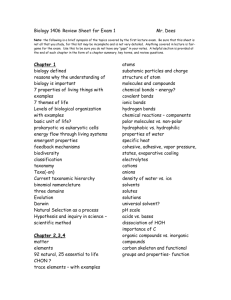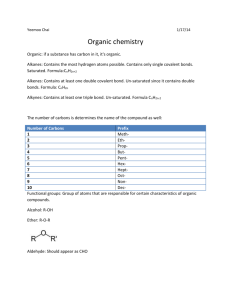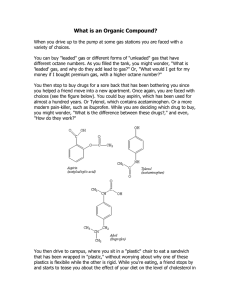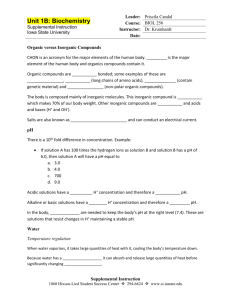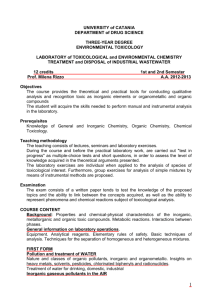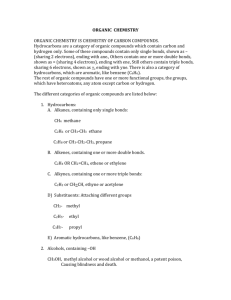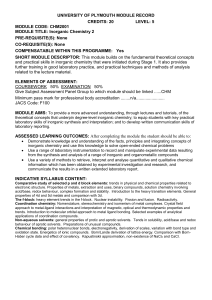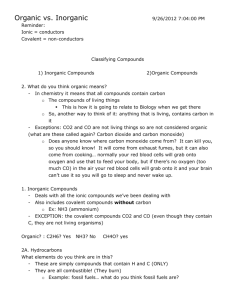Inorganic chemistry
advertisement
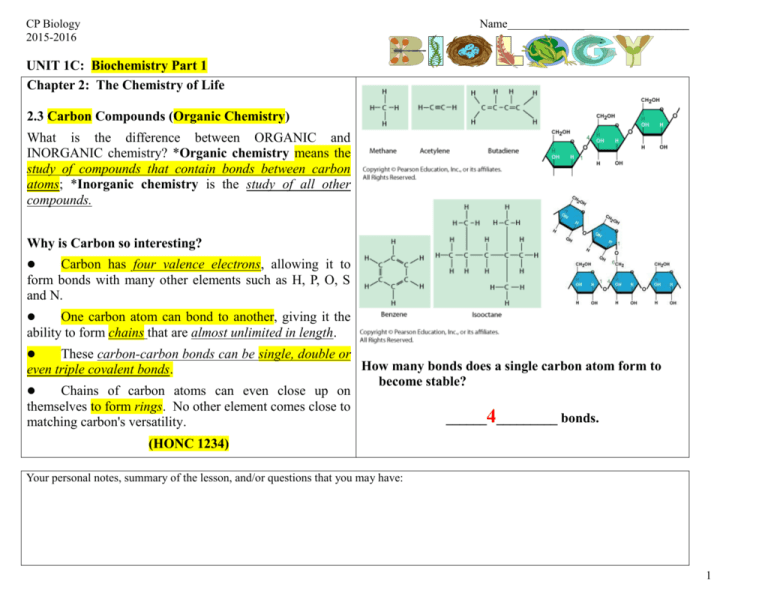
CP Biology 2015-2016 Name ______ ____________ UNIT 1C: Biochemistry Part 1 Chapter 2: The Chemistry of Life 2.3 Carbon Compounds (Organic Chemistry) What is the difference between ORGANIC and INORGANIC chemistry? *Organic chemistry means the study of compounds that contain bonds between carbon atoms; *Inorganic chemistry is the study of all other compounds. Why is Carbon so interesting? Carbon has four valence electrons, allowing it to form bonds with many other elements such as H, P, O, S and N. One carbon atom can bond to another, giving it the ability to form chains that are almost unlimited in length. These carbon-carbon bonds can be single, double or How many bonds does a single carbon atom form to even triple covalent bonds. become stable? Chains of carbon atoms can even close up on themselves to form rings. No other element comes close to ______4_________ bonds. matching carbon's versatility. (HONC 1234) Your personal notes, summary of the lesson, and/or questions that you may have: 1 *ORGANIC COMPOUNDS: Are usually defined as compounds which contain carbon with hydrogen. (May contain additional elements such as O, N, P, K, S, Fe, Ca, Na, Cl and others.) Are produced only by living things (biotic). Range from simple to very complex. Contain strong, covalent bonds. Examples: CH4, C6H12O6, SUGARS, PROTEINS, FATS, OILS, DNA *INORGANIC COMPOUNDS: Usually defined as compounds that do not contain carbon with hydrogen. (exceptions may contain just carbon.) They often can be formed in the non-living (abiotic) environment, but : Can also be made by/found in living things. Examples: H2O, NaCl, O2, NH3, CaCO3, CO2 Identify whether each of the following compounds is organic or inorganic by placing a √ in the appropriate column. Substance Organic? Inorganic? 1. sodium chloride (table salt): NaCl 2. glucose: C6H12O6 X X 3. water: H2O X 4. heating oil: C14H30 X 5. chitin (a protein): C8H12NO5 X 6. thymine (a nitrogenous base): C5H5N2O2 X 7. sulfuric acid: H2SO4 X 8. oxygen gas: O2 X 9. ethanol: C2H5OH X 10. adenosine triphosphate (ATP): C10H16N5O13P3 X 11. carbon dioxide: CO2 X Your personal notes, summary of the lesson, and/or questions that you may have: 2 1 The General Structure of Macromolecules Many of the organic compounds produced by living things are so large that they are called *macromolecules which means giant molecules. Examples: Carbohydrates, lipids, proteins and nucleic acids. Most macromolecules are formed through a process called *polymerization in which large compounds are built by joining smaller ones together. The smaller repeating units called *monomers may be identical or different from one another. The large compounds which are formed from the joining of many monomers are called *polymers. Two monomers joined together are called a *dimer. The exception: Lipids are not composed of monomers and polymers. Instead, they take different forms which we will discuss later in this unit. Your personal notes, summary of the lesson, and/or questions that you may have 3 1


